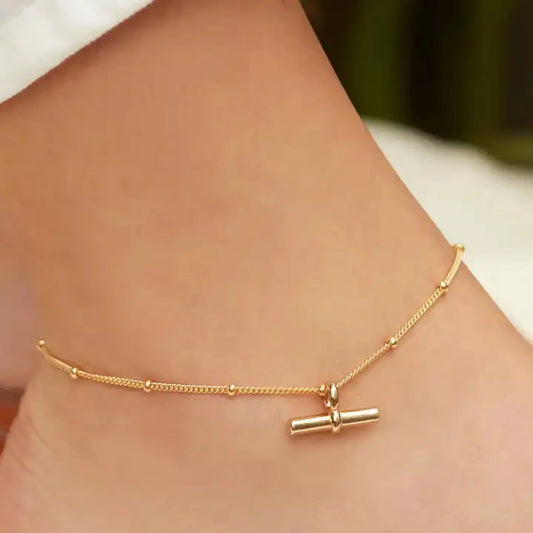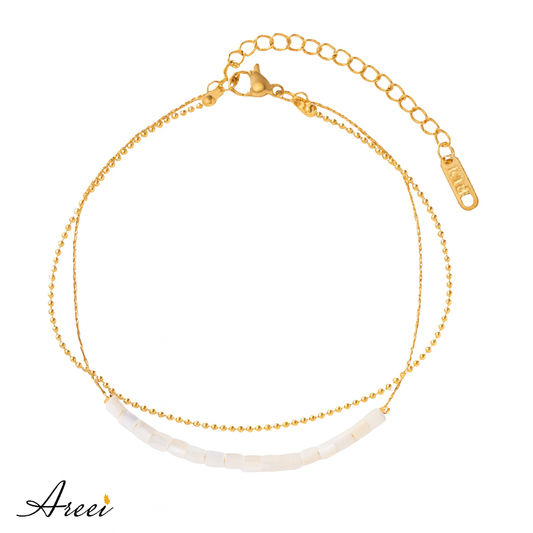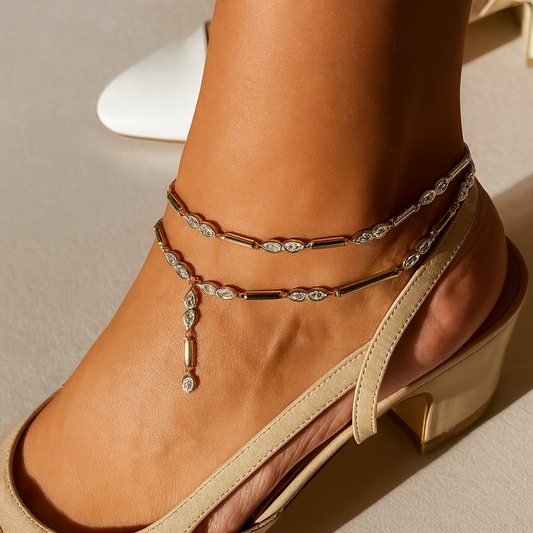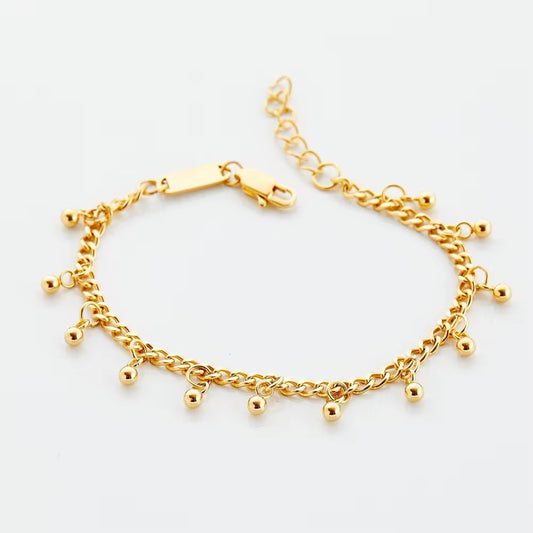Anklets have graced ankles across different cultures throughout history and they often carry rich symbolic meanings beyond their decorative appeal. Although in our world today many people wear anklets purely as fashion accessories, understanding the traditional symbolism behind different anklet colours, materials, and styles can give you deeper knowledge when you make jewellery choices.
From relationship status indicators to spiritual protection, anklets have communicated subtle messages for centuries. This article explores the fascinating world of anklet symbolism across cultures, helping you choose pieces that not only complement your style but also align with your personal intentions.
The Cultural Significance of Anklets Throughout History
Before diving into the different specific colour meanings, it's important to lay a foundation and understand how different cultures have used anklets symbolically:
Ancient Egyptian Anklet Symbolism
In ancient Egypt, anklets (called "khulkhal") were worn by women regardless of them being rich or poor. But the material of the anklet was what was used to indicate their social status:
- Gold and silver: Worn by nobility and the wealthy elite
- Copper and leather: Common among lower social classes
The Egyptian anklets often featured symbols of protection and prosperity, such as the Eye of Horus or scarab beetles.
Indian Anklet Tradition and Symbolism
In Indian anklets (known as "payal" or "pajeb") hold particularly rich significance:
- Silver anklets: Traditionally worn by married women, symbolising their marital status
- Gold anklets: Often avoided as gold is associated with Lakshmi, the goddess of wealth, and wearing gold below the waist was considered disrespectful
- Bell-adorned anklets: The tinkling sound was believed to announce a woman's presence and ward off negative energy
Even in the modern 2025 anklets remain an integral part of Indian bridal attire, symbolising prosperity and femininity.
Middle Eastern Anklet Cultural Meanings
Throughout the Middle East, anklets have been worn for centuries and it’s still being worn with various meanings:
- Bedouin traditions: Anklets with coins indicated family wealth
- Traditional dance: Bells and charms created rhythmic sounds enhancing performances
- Protection symbols: Certain designs were believed to ward off the evil
Western Adoption and Modern Interpretations of Anklets
In Western cultures, anklets gained popularity in the 1970s alongside the bohemian fashion movement:
- Initially it was associated with free-spirited and alternative lifestyles
- Sometimes it’s connected to specific relationship meanings (more on this below)
- Today largely it’s worn as fashion accessories without strict symbolic meaning
The Colour Symbolism of Anklets: What Each Hue Represents
A lot of people don’t know this but anklet colours have various meanings and sometimes they’re not just random colours that’s unattractive. Some of these so-called unattractive colours have meanings and when I say unattractive colours I’m not referring to gold or silver.
Gold Anklets
Symbolic meanings:
- Prosperity and abundance: Gold as we all know is usually represented wealth and success
- Divine feminine energy: In many traditions, gold is associated with feminine power
- Commitment: Sometimes gold anklets can symbolise a committed relationship
Silver Anklets
Symbolic meanings:
- Emotional balance: Silver anklet is associated with the moon and emotional stability
- Intuition and wisdom: Often connected to enhanced psychic abilities and inner knowing
- Purification: Silver has natural antimicrobial properties and is symbolically linked to cleansing
Red Anklets
Symbolic meanings:
- Passion and vitality: Red universally represents energy, love, and life force
- Protection: In many cultures, red thread or cord is used for protective purposes
- Courage and strength: Red is associated with the root chakra and feelings of security
Blue Anklets
Symbolic meanings:
- Communication and truth: Connected to the throat chakra in spiritual traditions
- Calm and tranquility: Blue evokes peaceful water and clear skies
- Protection against negative energy: Particularly turquoise blue in Middle Eastern traditions
Green Anklets
Symbolic meanings:
- Growth and renewal: Associated with plants, spring, and new beginnings
- Heart healing: Connected to the heart chakra and emotional wellness
- Abundance and fertility: In many agricultural societies, green symbolises prosperity
Black Anklets
Symbolic meanings:
- Protection and grounding: Black absorbs negative energy in many traditions
- Elegance and sophistication: A timeless colour that pairs with everything
- Mystery and independence: In some Western interpretations, black anklets can signal autonomy
Purple Anklets
Symbolic meanings:
- Spiritual awareness: Associated with the crown chakra and higher consciousness
- Creativity and imagination: Purple has long been connected to artistic inspiration
- Transformation: Represents the bridge between physical and spiritual realms
White Anklets
Symbolic meanings:
- Purity and innocence: Traditional associations across many cultures
- New beginnings: Like a blank slate ready for new experiences
- Spiritual devotion: In many religious traditions, white represents divine connection
These various meanings and symbols are not scientifically proven but they are just the general belief of people so you’re not exactly obliged to hold on to these meanings.
Material Symbolism: The Meaning Behind Different Anklet Components
Beyond colour, the materials used in anklets carry their own symbolic weight:
Metal Anklets
- Gold: Represents the sun, vitality, and divine feminine energy
- Silver: Connected to the moon, intuition, and emotional clarity
- Copper: Known for healing properties, particularly for joint issues
- Brass: Associated with harmony and attractive energy
Natural Material Anklets
- Leather: Represents connection to earth, durability, and natural strength
- Cotton or hemp cord: Simplicity, eco-consciousness, and casual energy
- Shell: Connection to the ocean, travel, and transformative experiences
- Wood: Grounding energy, stability, and connection to nature
Gemstone Anklets
- Turquoise: Protection during travel and spiritual journeys
- Amethyst: Spiritual growth and transmutation of negative energy
- Rose Quartz: Love, self-acceptance, and heart healing
- Clear Quartz: Amplification of intention and energy clearing
- Tiger's Eye: Confidence, courage, and protection
The Significance of Anklet Styles and Designs
The style and specific design elements of anklets can also carry meaning:
Chain Anklet Styles
- Delicate single chains: Minimalism, subtlety, and everyday wear
- Thick or heavy chains: Statement making, confidence, and boldness
- Multiple chains: Complexity, layers of meaning, and artistic expression
Charm Anklet Symbolism
- Heart charms: Love, affection, and emotional openness
- Evil eye beads: Protection from negative energy and envy
- Animal charms: Each carries specific meaning (dolphins for playfulness, elephants for wisdom, etc.)
- Bells: Traditionally believed to ward off negative spirits and announce one's presence
- Coins or discs: Prosperity, abundance, and good fortune
Anklet Position and Wearing Styles
In some traditions, the positioning of anklets carries significance:
- Right ankle: In some Western interpretations, signifies being single or unattached
- Left ankle: Sometimes interpreted as being in a relationship or married
- Both ankles: Independence and self-sufficiency
- With toe ring connection: Common in Indian tradition, emphasising femininity
It's important to note that these interpretations vary widely and aren't universally recognised. In most contemporary Western settings, the choice of which ankle to adorn is purely personal preference without relationship significance.
Anklets Across Different Spiritual Practices
Many spiritual traditions incorporate anklets with specific meanings:
Hinduism and Anklet Traditions
- Solah Shringar: The sixteen adornments for Hindu brides, including anklets
- Payal with bells: The sound is believed to please the goddess Lakshmi
- Silver toe rings and anklet combinations: Indicate marital status and promote health
Buddhist Anklet Practices
- Blessed cord anklets: Often tied by monks for protection and blessing
- Anklets with mantra charms: Carrying sacred syllables or prayers
- Simple designs: Reflecting Buddhist principles of non-attachment
New Age and Alternative Spirituality of Anklets
- Chakra-coloured anklets: Featuring seven colours representing energy centers
- Crystal-adorned designs: Harnessing specific stone energies
- Intention-set pieces: Modern practice of charging jewellery with specific purposes
How to Choose an Anklet Based on Symbolism
If you're interested in selecting an anklet for its symbolic meaning rather than just aesthetic appeal, consider these approaches:
Intention-Based Selection of Anklets
Identify your current needs: Protection, love, abundance, creativity, etc.
- Research colours and materials that align with those intentions
- Consider your personal connection to certain symbols or designs
- Trust your intuition when selecting pieces that resonate with you
Cultural Considerations of Anklets
When borrowing from specific cultural traditions:
- Research the authentic meaning behind designs you're drawn to
- Consider whether wearing certain styles might be considered appropriative
- Support artisans from the cultures whose designs you appreciate
- Understand the proper way to wear traditionally significant pieces
Practical Factors of Anklets
Balance symbolism with practical considerations:
- Lifestyle compatibility (active lifestyle may require sturdier designs)
- Wardrobe coordination (choose colours that complement your typical attire)
- Skin sensitivity (certain metals or materials may cause reactions)
- Climate appropriateness (heavier anklets may be uncomfortable in hot weather)
While anklets have carried specific meanings across cultures and throughout history, perhaps their most powerful symbolism comes from personal significance. Whether you choose an anklet based on traditional colour meanings, cultural significance, or simply personal preference, the meaning ultimately resides in your intention and connection to the piece.
Understanding the rich symbolic language of anklets allows you to make more mindful choices—selecting pieces that not only enhance your style but also align with your values, goals, and spiritual practices. From ancient traditions to modern interpretations, the humble anklet continues to serve as both beautiful adornment and meaningful symbol.
Whether you're drawn to the protective power of evil eye charms, the grounding energy of wooden beads, or the prosperity symbolism of golden chains, your anklet can serve as a constant reminder of your intentions and a beautiful expression of your personal style.









